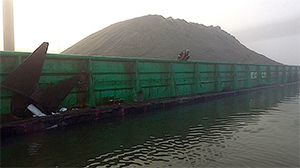A dredger operating on British Columbia’s Fraser River collided with a loaded barge after the dredger lost propulsion due to a power blackout that caused the air-powered engine clutches to disengage, the Transportation Safety Board of Canada (TSB) has determined.
FRPD 309, a conventional trailing arm suction dredger owned by Fraser River Pile and Dredge Inc., was operating on the river near Delta, B.C., when the collision occurred at 0432 on Dec. 5, 2017. The vessel had been dredging sand and sediment into its hopper and pumping it ashore via a pipeline.
The master left the bridge at approximately 2100 on Dec. 4, handing over command to the officer of the watch (OOW). Two engineers, two deck hands and a pipe operator also were on duty. By 0347 on Dec. 5, the vessel had completed two discharges of the hopper. When the hopper was full again at 0420, the OOW began turning the dredger to port to proceed to the discharge pipeline.
During the turn, at 0423, FRPD 309 experienced a blackout. Approximately two to five seconds elapsed before the power management system restored electrical service. The second engineer quickly started the third generator so that the load could be increased to operational levels.
Once power returned, the bridge team was able to reset the electronic equipment that had tripped. Approximately two minutes after the blackout, the OOW resumed the turn and the vessel continued toward the pipeline.
“However, at this time, the two engineers in the engine room were still resetting numerous alarms and both essential and non-essential circuit breakers that had tripped, including some located in the fore part of the vessel, and they did not have enough time to restore the vessel to normal status before it resumed the voyage,” the TSB report said.
 |
|
The dredger’s port anchor wedged in the hull of the barge. |
|
Courtesy TSB |
At 0430, FRPD 309 was proceeding to the pipeline at approximately 7.2 knots when propulsion was lost; the main engine clutches had automatically disengaged after the control air pressure fell below 5 bar. The dredger was still moving forward, however, putting it on a collision course with the tug Storm Wave, which was towing the loaded barge Evco 60 in the vicinity.
The OOW on FRPD 309 applied the rudder to starboard, attempting to steer the dredger away from the tug and tow. He also notified Storm Wave that FRPD 309 had lost propulsion and requested that the tug keep out of the way.
At 0432, the dredger collided with Evco 60 while making way at approximately 4.5 knots. FRPD 309 then anchored and crew communicated with Storm Wave, which continued on its voyage after assessing damage to the barge. After regaining propulsion, FRPD 309 proceeded to a shipyard in Delta, B.C., for repairs.
FRPD 309 sustained damage to its shell plating and forepeak tank. Its port anchor also disconnected and became wedged in Evco 60’s hull. The barge, owned by Lehigh Hanson Materials Ltd., sustained structural damage. Storm Wave, owned by Ledcor Resources and Transportation, was not damaged.
TSB investigators could not determine the cause of the blackout. The report said that after it occurred, the dredger resumed its transit toward the discharge pipeline almost immediately, without allowing time for the engine room crew to reset all of the alarms and breakers and to verify the operational status of the vessel’s systems and equipment.
Following the incident, Fraser River Pile and Dredge revised its safety management system documentation related to emergency checklists and loss of propulsion; revised familiarization and training, and briefed the crew on these changes; implemented training for all deck and engine room crew concerning safe parameters for air clutches and air telegraph; conducted emergency drills related to failure and maintenance of the control air systems; and fitted a control air compressor with auto-start capability.

